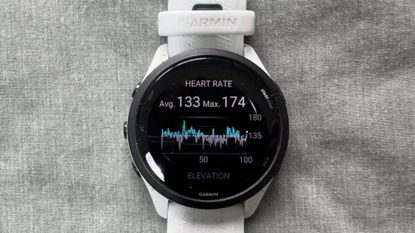Garmin Forerunner 265 smartwatch review - excellent for sports tracking, less so for mapping
The health tracking metrics and GPS accuracy are excellent, but you don't get full topographic mapping

The Garmin Forerunner 265 left me seriously impressed. From the easy-to-navigate touchscreen design to the array of activities and widgets - the list goes on. The one thing I did find let me down was the inaccuracy of the heart rate monitor - but with the vibrations through the bars and the bulky cuffs of deep-winter jackets, I've yet to come across a wrist-based heart rate monitor which does provide accurcate date in these conditons, so I was content to overlook this.
-
+
Great GPS accuracy
-
+
Intuitive to use
-
+
Ability to record a host of different sporting activities
-
+
Battery life was impressive, lasting over a week before the need to charge
-
+
Can store music
- +
-
-
Inaccuracy of heart rate readings during cycling
-
-
Accuracy of maps whilst out exercising
You can trust Cycling Weekly.

The Garmin Forerunner 265 is an excellent sports watch, and is designed for so much more than just sports. So much so that over the testing period I haven't wanted to take it off thanks to all, thanks to all the features it offers. From sleeping patterns to stress levels and of course activity tracking, it really is a superbly well rounded smartwatch.
Garmin Forerunner 265: construction
You only have to quickly head to the Garmin website and scroll through the list of specs for this watch to see it has been designed for everyone and anyone. From a whole variety of different sporting activities, it is able to track such as the likes of cycling, mountain biking, indoor cycling - even paddleboarding and ice hockey, the list is seemingly endless and it doesn’t stop there.
The Forerunner 265 has a host of widgets and tracking capabilities. Each morning the watch gives you an overview of how well you slept, your training readiness and body battery, to name a few. It even detects moments of stress and advises you to take some time to wind down - which, in a world where things can be so full on, I found to be very helpful.
The Forerunner 265 is highly adaptive, perfect for personalization to suit you and your lifestyle. There is a host of different watch faces, so you can find and personalize the ones best suited to you - plus there are options to set up Garmin Pay and store music. This list also goes on and on, so to keep things brief, I will just be focusing on a selection of the most useful features in this review.
The watch comes in a choice of two sizes, a 42mm for smaller wrists and 46mm for slightly larger wrists like my own. The actual measurements came up as 46.1 x 46.1 x 12.9mm, which felt very comfortable when worn, without being too bulky or feeling like it was in the way. This was especially noticeable when heading out the door in multiple cycling jackets in an attempt to keep warm at this time of year.
Available in six different colours in each size, there are plenty of options and, personally, I felt they all looked smart enough to be worn away from the bike, as well as on. The lightweight design of only 47g helped with this and I found in day-to-day living I almost forgot I was wearing the watch completely.
The silicon band proved to provide the perfect fit, with a huge array of different holes to size the watch up on your wrist to your preferred tightness. I was impressed by the overall comfort of the construction and it felt pleasant to wear, even when out on the bike under multiple layers.
Garmin Forerunner 265: the ride
Health and fitness features

Arguably the most important aspect of a sports watch is its ability to track fitness and activities. Luckily the Forerunner 265 has you covered for pretty much every sporting activity possible. From the likes of lacrosse to baseball, this watch has you covered - and when it comes to cycling there is a variety of different options including mountain biking, road cycling and indoor.
When out riding, I found the GPS tracking to be highly accurate. I compared it against my Garmin Edge bike computer, and both gave me the same readings for distance and time. The auto pausing also worked wonders: every time I came to a junction it would automatically stop and start up again without fail or excessive delay.
The one thing I found to be not quite so accurate was the heart rate recording. I have had problems with many wrist based heart rate monitors in the past, and put this down to the fact when you are out riding there can be quite a lot of vibrations going up through the bars.
During a VO2 max efforts session, I would look down to check what my heart rate was and I found it to be all over the place. During the effort, it would be reading around 130 BPM, whreas during the easy periods it would be far higher - even though I was hardly pedalling.
During everyday life I did find the readings to appear far more accurate. Even out on one of my rides, at least the average heart rate of 133 BPM did seem about accurate for the perceived exertion I put out.
Mapping

The Garmin 265 will show a 'breadcrumb trail' - essenitlaly a line on a blank background - rather than having detailed base maps with roads, streets and trails all clearly depicted.
It can help to provide a sense of where you are relative to where you've been. But if you are interested in a smartwatch with detailed mapping, you'd be better off with a model like the Forerunner 955 or 965.
Battery life
The watch impressed when it came to battery life. For context, my Apple Watch Series 8 requires charging everyday, whereas the Garmin Forerunner 265 watch went well over a week without the need to be charged. Garmin claims that during smartwatch mode only it only requires charging every 13 days and in GPS mode it can last up to 20 hours.
Out during testing, I found the watch just in GPS mode would lose around seven to 10 per cent of its battery per hour of activity, which works out at around 10 to 14 hours of battery. So, a little less than that claimed but still sufficient for the everyday cyclist. Even if you do let the battery level drop considerably low, the watch fully charges in a little over an hour - which I found to be pretty impressive.
Other features
The Forerunner 265 goes above and beyond in terms of its capabilities and as mentioned earlier. I could bore you all day, but the most useful I found was its ability to store music. Not an essential feature for many of us when going out cycling , as you'll likely also have your phone with you anyway. But when it comes to gym workouts or going out running, being able to leave my phone behind or easily skip songs or turn up the volume was something I really enjoyed.
This next feature wasn't so relevant to me, as I have a coach who sets my weekly sessions, but the Forerunner 265 can also give you recommendations of what training sessions to do each day.
By taking into account your training readiness (which is factored by things such as your sleep score, acute load and stress over the past few days), it can be a great feature for those who want a little more structure with their training. For those who don't need this feature, you can easily turn it off.
Garmin Forerunner 265: value and conclusion
At $449.99 / £429.99, I thought that the Forerunner 265 was good value for money. Although the latest Apple Watch Series 9 starts from $399 / £399, the Forerunner 265 is more of a 'complete' sports watch, with the mixture of training status and stats it gives you.
I did really fall in love with this watch and its ability to be both a sports watch and everyday watch - from the accurate GPS recording systems to its ability to tell you the weather, store music and track your sleep. The one thing I was let down with was the inaccuracy of the heart rate recordings, but as you can easily use a chest strap to measure this accurate (if you care about that data), I didn’t find it to be too much of a problem.
Garmin Forerunner 265: specs
- Size: 46.1 x 46.1 x 12.9mm
- Weight: 47g
- Display resolution: 416 x 416 pixels
- Lens glass: Corning Gorilla Glass 3
- Connectivity: Bluetooth, ANT and WIFI
- Battery life: Up to 13 days
- Music storage: Yes
- Garmin Pay: Yes, but limited to certain banks

Thank you for reading 20 articles this month* Join now for unlimited access
Enjoy your first month for just £1 / $1 / €1
*Read 5 free articles per month without a subscription

Join now for unlimited access
Try first month for just £1 / $1 / €1
Get The Leadout Newsletter
The latest race content, interviews, features, reviews and expert buying guides, direct to your inbox!

Tom Couzens is a racing cyclist currently representing The Ribble Collective on the road and the Montezumas cyclo-cross team off road. His most notable results include winning the Monmouth GP national series race as a junior; finishing sixth in the 2022 British National Cyclo-cross Championships; and he was selected to represent Great Britain at the European Cyclo-cross Championships in 2020/21. Tom draws on his high-level racing experience and knowledge to help Cycling Weekly readers maximise their potential and get as much as possible out of their riding.
-
 In search of the world's best club jersey: Jubilee Park CC v Kibworth Velo Club
In search of the world's best club jersey: Jubilee Park CC v Kibworth Velo ClubEvery week we pit two club kits against each other and you get to vote on the best designs
By James Shrubsall Published
-
 'I had to wait at the top of every hill' – the highs and lows of Malcolm Elliott's career in the fast lane
'I had to wait at the top of every hill' – the highs and lows of Malcolm Elliott's career in the fast laneThroughout his two-part career, no-one epitomised Sheffield steel like Cycling Weekly's 2023 Lifetime Achievement award winner Malcolm Elliott
By James Shrubsall Published
-
 'I never wanted to be known as the TikTok cyclist' - how Alison Jackson wrote her legacy at Paris-Roubaix
'I never wanted to be known as the TikTok cyclist' - how Alison Jackson wrote her legacy at Paris-RoubaixThe Canadian tells Cycling Weekly how a day across the cobbles of northern France changed her career
By Tom Davidson Published


